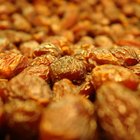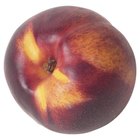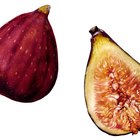
Native to the Mediterranean, fig trees have found their way to the United States where the trees are grown in warm, semi-arid climates. Although figs have a delicious taste, the sweet fruit lasts only a few days after harvest. If you have a fig tree, or if you have more figs than you can eat fresh, drying is an effective way to preserve flavor and quality. While figs can be dried in the sun, oven-drying is an easy alternative.
Sort your figs and select fresh, undamaged, unbruised figs for drying. Set bruised figs aside and use the figs immediately. Discard spoiled or badly bruised figs.
Preheat your oven to 140 degrees F. Spread the figs in a single layer on a baking pan or cookie sheet.
Place the figs in the oven. Leave the oven door open 2 to 3 inches to allow moisture to escape and to keep the oven from getting too warm. Place a portable fan directed at the oven door to provide extra air circulation to the figs. Use tongs to turn the figs every few hours to ensure that the figs dry evenly.
Check the figs every one to two hours, as drying time varies from six to 12 hours, depending on the temperature in your oven and the size and moisture content of the figs. Squeeze the figs to determine dryness. The figs are dry enough when the fruit is firm on the outside. The inside of the figs should be soft, but release no juice when squeezed.
Remove the figs from the oven and allow the figs to cool completely. Place the cooled figs in a zip-seal bag and store the figs in the refrigerator or freezer. Figs are safely stored at room temperature in a clean, airtight container if the insides are completely dry. Store the figs in a dry, cool, dark place.
Related Articles

How to Refresh Dried Fruits: Raisins

Are Bananas Safe to Eat if the Skin Is ...

How to Dehydrate Kiwi

How to Bake Nectarines Like Peaches

How to Dry Pineapple in a Dehydrator

How to Store Brussels Sprouts

Should I Refrigerate Figs?

How to Dry Figs in a Microwave

How to Dry Blueberries in a Dehydrator

How to Dry Jujube Fruit

How to Store Apples

How to Dry Radishes

How to Freeze Figs

How Much Fiber Is in Fresh Figs?
Can You Make Fig Preserves Out of Dried ...

How to Dry or Preserve Blueberries

How to Keep Pomegranate Fresh

How to Dry Artichokes

How to Steam a Banana

Fruits & Vegetables Rich in Potassium ...
References
Writer Bio
M.H. Dyer began her writing career as a staff writer at a community newspaper and is now a full-time commercial writer. She writes about a variety of topics, with a focus on sustainable, pesticide- and herbicide-free gardening. She is an Oregon State University Master Gardener and Master Naturalist and holds a Master of Fine Arts in creative nonfiction writing.
Photo Credits
Jupiterimages/Photos.com/Getty Images